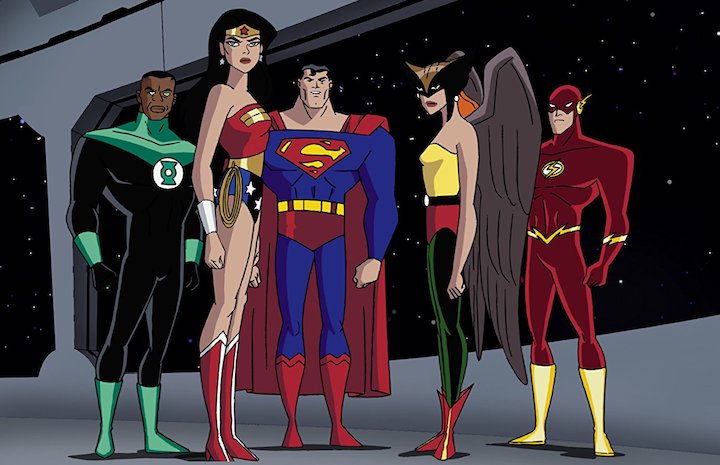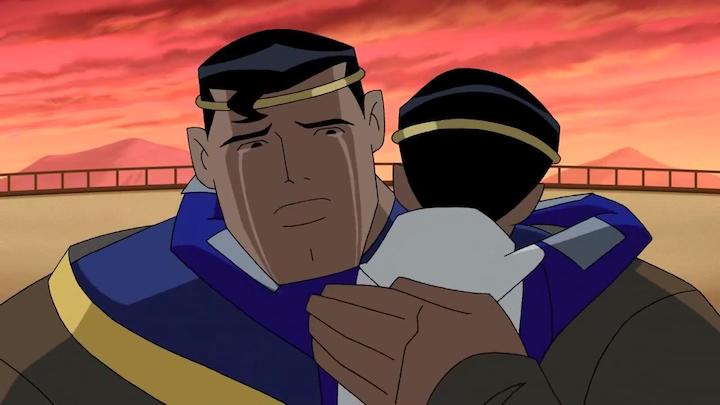The JUSTICE LEAGUE may have hit theaters earlier this month, but the League came together on the small screen back in 2001 as part of the DC Animated Universe. Even 16 years later, it’s considered one of the best superhero cartoons of the 21st Century.
Following the successful runs of the Batman and Superman animated series in the 1990s, run by Bruce Timm and Paul Dini, Warner Bros. Animation upped the stakes at the turn of the century with a new series on Cartoon Network featuring DC Comics’ premiere super-team, the Justice League. Unlike the half-hour adventures that the Caped Crusader and the Man of Steel were featured in, the Justice League series was designed with two-part stories with the focus rotating around the seven main characters: Superman, Batman, Wonder Woman, The Flash (Wally West), Green Lantern (John Stewart), Martian Manhunter and Hawkgirl.

The first season of the show, which premiered on November 17, 2001, was a special three-part movie that showed the League coming together against alien invaders from Mars (much like the WHITE MARTIANS the Big 7 faced in Grant Morrison’s first arc on JLA).
Each subsequent arc featured a who’s who of DC Comics characters, from the Green Lantern Corps and Kanjar Ro to Etrigan the Demon and Metamorpho. Many of the heroes who made appearances had never had never appeared outside the comics, and many could be considered pretty obscure to non-comics fans. But that’s part of what made the two seasons of Justice League such an amazing series for comic book fans.
One of my favorite two-parters from the first season, “War World,” featured Superman and Martian Manhunter battling Mongul on the titular planet, after they were abducted by alien slave traders.
The stakes were raised in the show’s second season, as bigger villains – including Darkseid, Amazo, Gorilla Grodd and Eclipso – were featured as threats to the team. The second season also introduced the Justice Lords, a version of the heroes from a parallel Earth where Lex Luthor killed Flash and set the heroes off on a despotic rule. In the two-parter, “A Better World,” the Justice Lords’ Batman discovers the prime Earth and sets the Lords out to conquer that, too, echoing stories pitting the JLA against their Earth-3 counterparts, the Crime Syndicate, from the comics.
With the three-part season finale of the show’s second year, featuring an invasion from the Thanagarian Hawk people and the loss of trust of Hawkgirl, the show changed its name and its format going forward. Starting in July 2004, just two months after the “Starcrossed” three-parter aired, JUSTICE LEAGUE UNLIMITED debuted its new half-hour format with the same art style.
Instead of featuring just the seven members of the League, the team expanded to include a rotating base of heroes who were used on an as-needed basis. Every half-hour episode included original members of the animated League teamed up with newcomers who hadn’t been featured in the first two seasons. DC Comics heroes like Green Arrow, Black Canary, Captain Marvel, Booster Gold, The Question and others all got featured spots on JLU episodes.

While JLU was a great series to watch from beginning to end, featuring more episodic elements from week-to-week than its predecessor had, one of the highlights came with the second episode, “For The Man Who Has Everything,” which adapted Alan Moore’s amazing Superman story to an animated tale. Superman, captured by a plant called the Black Mercy, has to be rescued by Batman and Wonder Woman, as he battles out of a world created to fulfill his greatest desires. Kal-El is back on Krypton, which never exploded, and he has a wife and child. Superman is not pleased when that’s taken away from him.
One of the things that helped make both Justice League and Justice League Unlimited fun on a comic book scale is having actual comic book writers crafting stories. Over the course of the 91 episodes (between the two series), acclaimed comic book writers like Dwayne McDuffie, JM DeMatteis, Gail Simone, Warren Ellis, Jim Steranko and Darwyn Cooke provided scripts for episodes.
Timm’s version of the DC Animated Universe came to a close with JLU’s final episode, on May 13, 2006, with a final battle between Superman and Darkseid, a fitting way to end the series. Timm would move on from doing episodic animated television to heading up the new DC direct-to-video movies, which debuted in 2007 with Superman: Doomsday.
